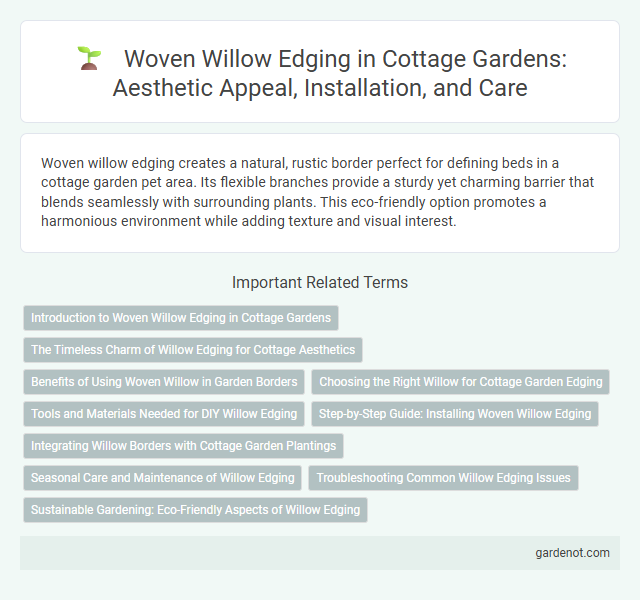Woven willow edging creates a natural, rustic border perfect for defining beds in a cottage garden pet area. Its flexible branches provide a sturdy yet charming barrier that blends seamlessly with surrounding plants. This eco-friendly option promotes a harmonious environment while adding texture and visual interest.
Introduction to Woven Willow Edging in Cottage Gardens
Woven willow edging provides a natural, rustic boundary that enhances the charm of cottage gardens while promoting sustainable gardening practices. Crafted from flexible willow branches, this edging method offers durability and breathability, allowing roots to thrive along flower beds and pathways. Its organic texture blends seamlessly with perennial borders, creating a visually appealing yet functional garden structure.
The Timeless Charm of Willow Edging for Cottage Aesthetics
Woven willow edging beautifully complements cottage garden aesthetics by adding a natural, rustic boundary that enhances the charm of flower beds and pathways. Its flexible, sustainable material blends seamlessly with traditional cottage plants like lavender and roses, creating a cohesive, inviting space. Crafting this edging by hand emphasizes artisan skill and durability, ensuring the garden maintains its timeless, enchanting appeal through seasons.
Benefits of Using Woven Willow in Garden Borders
Woven willow edging offers natural durability and flexibility, making it ideal for defining garden borders in cottage gardens. Its breathable structure supports healthy soil moisture levels while providing an eco-friendly, biodegradable alternative to plastic or metal edging. This sustainable material enhances aesthetic appeal with its rustic charm, blending seamlessly into traditional garden designs.
Choosing the Right Willow for Cottage Garden Edging
Selecting the right willow for cottage garden edging involves prioritizing flexibility, durability, and natural aesthetic appeal. Common choices include Salix viminalis, known for its slender, pliable rods ideal for weaving, and Salix purpurea, which offers a rich color variation enhancing the garden's charm. Properly harvested in late winter or early spring, willow rods maintain strength and longevity, ensuring sustainable and attractive cottage garden borders.
Tools and Materials Needed for DIY Willow Edging
Creating woven willow edging for a cottage garden requires supple willow rods, ideally freshly harvested in late winter for optimal flexibility. Essential tools include sharp pruning shears for cutting, a weaving needle or bodkin to guide the rods, and garden twine to secure ends during assembly. A sturdy wooden or metal frame offers support throughout the weaving process, ensuring neat and durable edging.
Step-by-Step Guide: Installing Woven Willow Edging
Start by marking the garden border and clearing the soil of weeds and debris to create a smooth, level surface for installation. Soak the willow rods in water for 24 hours to increase flexibility, then weave them vertically into sturdy stakes hammered along the marked edge, intertwining horizontally for strength. Finish by securing loose ends and trimming excess willow, ensuring the edging maintains its shape and blends naturally into the cottage garden design.
Integrating Willow Borders with Cottage Garden Plantings
Woven willow edging seamlessly integrates with cottage garden plantings by providing a natural, rustic boundary that enhances the garden's charm and structure. Its flexible, organic texture complements flowering perennials and herbaceous plants, creating a harmonious contrast while defining garden beds. This sustainable edging method supports biodiversity by offering shelter for beneficial insects, aligning perfectly with the ecological ethos of cottage gardens.
Seasonal Care and Maintenance of Willow Edging
Woven willow edging thrives with seasonal care that includes regular pruning to maintain its shape and prevent overgrowth during spring and summer. Applying a protective mulch base in autumn helps conserve moisture and insulate roots through colder months, ensuring longevity. Inspecting for damage and reweaving loose sections in early spring restores structural integrity and enhances the natural aesthetic of the cottage garden.
Troubleshooting Common Willow Edging Issues
Woven willow edging may experience common issues such as loosening, splitting, or fungal growth due to moisture retention. To troubleshoot these problems, ensure proper installation with tight weaving, regularly inspect for damage, and maintain good drainage around the edging. Applying natural preservatives and timely repairs can extend the lifespan and appearance of willow garden borders.
Sustainable Gardening: Eco-Friendly Aspects of Willow Edging
Woven willow edging offers an eco-friendly solution for sustainable gardening by utilizing fast-growing, renewable willow branches that require minimal processing and no synthetic chemicals. This natural boundary supports soil health by promoting aeration and water retention while providing habitat for beneficial insects. Choosing willow edging reduces plastic waste and enhances a cottage garden's biodiversity through its fully biodegradable and recyclable properties.
Woven willow edging Infographic

 gardenot.com
gardenot.com